Review Article 
 Creative Commons, CC-BY
Creative Commons, CC-BY
Artificial Intelligence: Predictive vs Generative vs New Mixing AI
*Corresponding author: Jorge Garza Ulloa, Research Consulting Services garzaulloa.org, University of Texas El Paso, USA.
Received: May 06, 2024; Published: May 10, 2024
DOI: 10.34297/AJBSR.2024.22.002973
Abstract
In traditional computer linear programming, the programmer tells the digital device what to do based on the input data processed to generate the desired output. Then, a general trend in programming software for smart digital devices was based on exponential Artificial Intelligence (AI), where they use data and many algorithms to learn how to reach the desred output and forecast future values, identified now as “predictive AI,” which has a greater disruption with AI technology. Last year, a new AI branch was identified as “Generative AI,” with the objective of creating new contents based on Large Language Model (LLM) datasets with a bigger disruption to new AI technology, while “Predictive AI” is based on historical data to forecast future outcomes. Both are very important, and together, different combinations are used to obtain many optimized AI models to select the best option, known as “mixing AI.” AI algorithms running on smart devices locally or in the cloud are known as “Computing Intelligence (CI).” In this paper, the focus is to study the difference between the two general branches of “Artificial Intelligence: Predictive AI vs new Generative AI vs Mixing AI,” and their respective positive advantages as benefits and negative AI disadvantages as threads (Figure 1).
Introduction
AI can be categorized in many branches as shown in Figure 2, these are: "AI learning", "Machine Learning", "Deep Learning", "Cognitive Learning", "Generative AI" and continue usually evolving in new branches covering concepts from previous AI branches, adding new ones as documented in full on chapter 1 of Biomedical engineering and the evolution of artificial intelligence [1] Each new AI branch adds many “benefits that are indicated with green background” at the top of Figure 2 and also “threats that are indicated with red background” on the same figure (Figure 3).
Introduction to Predictive AI Versus Generative AI
In a general way, we can divide AI into two general branches based on the dataset model sizes and general objective goals of “predictive AI” and "generative AI,” as shown in Figure 3. Where:
1. “Predictive AI or Predictive AI Learning” is based on smart computer algorithms that predict future outcomes by analyzing historical data from “small to medium dataset models” to predict decisions analyzing historical data based on probability and statistical modeling, This includes "AI learning," "machine learning," "deep learning," "cognitive learning," and others currently in development, as represented in Figure 2.
2. "Generative AI or Generative AI Creation " is based on computer algorithms known as "Large Language Models (LLM)" dataset models to create new content such as text, images, video, music, coding, and other types of data to learn from an existing large amount of mainly “unlabeled data to generate new data based on similarity found on the training data based on predicting the next value using statistical processes.”.
In the following table, a comparison between traditional “predictive AI” and the new era “generative AI” is indicated with general descriptions, including advantages and disadvantages, issues, and general examples where they are used (Table 1).
Predictive AI Versus Generative AI Positive and Negative Issues & Apps
“Predictive AI” is focused on the imitation of intelligent human behavior using software processes to obtain predictions to enable smart devices to “mimic in some ways the human intelligence” through software running on computer systems that can be local or in the clouds.
“Predictive AI” is based on different AI models, including “learning,” “reasoning,” and "self-correction, “to obtain values used to predict the best decisions by applying probability and statistical data obtained to deduce the next values (Figure 3).
As shown in Figure 3, predictive AI predicts future outcomes by analyzing historical data, these can be positive or negative effects based on their application goals.
1. “Predictive AI positive effects “are useful applications to improve analysis and take the best decisions in different fields, such as:
a. “Process automation" is used to automatically control processes in many areas, such as chemical, oil refineries, paper, pulp factories, etc.
b. “Smart decision making” based on AI models to obtain optimized results for improving general business goals, inversions, etc.
c. “Enhanced customer experience” with AI models for personalization, efficiency, and engagement with services offered.
d. “Increasing business efficiency” describes how effectively a company generates products and services related to the number of resources needed to produce them.
e. “Health care efficiency" is based on optimal results of the analysis of comparison of delivery system outputs, such as physician visits, relative value units, or health outcomes, with inputs like cost, time, or material.
f. “Data analysis for efficient research" is the is the optimization of the complete process for collecting, modeling, and analyzing data using various statistical and logical methods and techniques to extract insights that support strategic and operational decision-making.
g. Endless applications
2. “Predictive AI negative effects” are prejudiced applications to alter the human’s natural development of natural intelligence, besides affecting environmental- thresholds, society's cultural roots, and obtaining unacceptable economic or political advantages [2].
a. “Social manipulation" involves applying AI algorithms with rewards to control human behavior and natural choices. i.e., Instagram, Tik Tok, Twitter, Meta (Facebook), etc.
b. "Deepfake" is digitally manipulated to replace one person's likeness convincingly with that of another, altering images, sounds, videos, and the normal behaviors of specific people.
c. “Social surveillance" is based on using AI surveillance technologies to map, track, and control people to meet various policy aims, some of which fall into a gray area.
d. “Cyber-attack" is any intentional effort to steal, expose, alter, disable, or destroy data, applications, or other assets through unauthorized access to a network, computer system, or digital device.
e. Many others
As shown in Figure 3 right bottom, “generative AI” based on large language models is mainly used for apps to create new content of text, images, music, code, video, and other endless applications for industries and business services as follows:
3. “Generative AI positive effects “are useful applications integrating LLM models to improve existing systems and processes, allowing new functionality levels in different fields such as:
a. Manufacturing Optimization
i. “Integration to systems and processes for manufacturing machine operators" leads to faster data categorization, generating alerts, and allowing faster context for optimal options.
ii. “Removing barriers for manufacturing engineers” allows faster responses to problems with efficient tools to improve the quality of manufacturing items.
iii. “Real time visualization of data production” to detect faster problems across the manufacturing process.
iv. Others
b. “Financial optimized services” is another exponentially growing area with the integration of “generative AI,” which applies its abilities to create, innovate, and analyze huge amounts of data to optimize complex tasks and operations with faster decisions to optimize resources, reduce costs, mitigate financial risks, and others.
c. “Media and entertainment creation” with content enhancement within the media and entertainment industry with automated video and sound and personalized user content at lower costs.
d. “Business and customer care efficient” using customer service agents for autogenerating responses, translating requests and responses, and even creating response libraries for common requests.
e. “Education, learning, and training exponential evolutions” applies “generative AI” for students in many tasks such as homework assistants, essay generation, multimedia generation, and others, developing agile learners who are now capable of adapting to new and unexpected scenarios with many variables helping them to innovate and allowing adaptation to new scenarios. And educators that now must evolve the traditional teaching, adding a new useful focus on higher-level personal skills, i.e., critical thinking, analysis optimized strategy, resilience, etc [3].
f. “Consumer goods and retail based on analyzing customer data,” i.e., purchase history, browsing behaviors, preferences, etc., creates instant personalized recommendations and offers an enchanting shopping experience while increasing the likelihood of other products and services.
g. “Healthcare and medicine with exponential acceleration” means many things, i.e., improved medical imaging, reduced administrative burden, predictive maintenance of medical devices, interpreting unstructured data, medical robots, etc.
h. Others
4. “Generative AI negative effects” are dangerous issues and threats based on deviations from expected results or the development of services or applications with the intent of prejudice, targeting the alteration of a human’s natural development of their natural intelligence, affecting environmental- thresholds, society's cultural roots, and obtaining unfair and/or unacceptable advantages.
The actual main negative issues to be resolved are:
a. “Hallucinations” are text extracted from the large model dataset according to the relation from the query users without analyzing its real meaning.
b. “Biases” refers to the occurrence of altered results influenced by the information available on the dataset exiting the trained actual model.
c. “Jailbreaks” are deviations from the original query that produce undesired responses.
d. “Anonymity” is based on the original data ID that is lost by the conversion into the large language model unstructured data transformation, where individual identification becomes impossible to follow.
5. The actual main negative threats are
a. “Customer Data Privacy and Security Concerns” are found in the LLM ingest data, creating inferences without any reference to personal information or any request for copyright information.
b. “Lacking a Human-Centric Element*” is needed based on the importance of assisting users with the assurance of correct answers in different fields such as assist shoppers, product recommendations, e-commerce websites, health analysis, and many others.
*See Section Human In The Loop (HITL) for more information.
c. All the negative effects described in the section “Predictive AI Negative Effects” are detected again, but on a large scale at “Generative AI," such as social manipulation, deepfake, social surveillance, and many others.
*i.e., Cyber-Attack in Generative AI could launch malicious attacks on companies working on AI, big data, quantum computing, healthcare, pharmaceuticals, and especially military technologies. These cyberattacks could be very fast, repetitive, and using different methods with a very high probability of success to gain control over access data, including intellectual property, and destabilize the operations of companies and government agencies requesting ransoms by selling back control over their systems, including backup.
Positive and negative AI apps or services is taking us to decide the importance of protecting us in two ways: personal and general:
A. “Personal: find by ourselves the healthy balance between natural and artificial intelligence," where the need to recognize our “true identity” under the environmental-threshold, society, and cultural roots, that naturally serve as the basis of the development of our “natural cognition," “memory”, "learning,” and “thinking” has been altered, limiting the development of “natural intelligence potentialities," which are defined as intelligence for bodily-kinesthetic, linguistic, logical-mathematical, spatial, musical, intrapersonal, interpersonal, naturalist, and “mature natural intelligence potentialities” as existential, spiritual, moral, and many others. All of them are misleading for the overuse of “artificial intelligence” to generate more fascinating and useful technologies, but unfortunately, it is often used to manipulate us for commercial, economic, political power, and other issues [2].
B. “General: AI regulation” is needed and expected but is complicated to realize because it demands a society-wide effort from everybody involved, including the government, private sector, academia, and civil society. “AI regulation for a responsible AI using a guide tech based on humanities perspectives to be applied for government divisions. “Responsible AI” has the potential to help solve urgent challenges while making our world more prosperous, productive, innovative, and secure. But opposite the need to stop applications identified as “irresponsible AI,” that exacerbates societal harms such as fraud, discrimination, bias, and disinformation; displaces and disempowers workers; stifles competition; and even poses risks to national security. The goal of achieving intelligence is that it must be safe and secure. Meeting the goal requires robust, reliable, repeatable, and standardized evaluations of AI systems, as well as policies, institutions, and as appropriate, other mechanisms to test, understand, and mitigate risks from these systems before they are put to use [4].
Traditional Predictive AI Detail Description
All traditional "AI models" are usually trained with medium-sized datasets for learning to predict future outcomes based on historical data. It includes the following specific “AI branches,” as shown in Figure 2:
1. "Artificial Intelligence Learning" These are computer programs that are based on "simulating natural solutions" as a process of natural selection to find the best solution to problems. i.e., "evolutionary algorithms” that emulate natural evolution, such as [5]:
a. “Genetic Algorithms,” based on genes, capture the evolutionary responses of prior populations to selection on behavior.
b. “Swarm Algorithms,” are based on natural methods observed in natural systems such as ant colonies, bee colonies, bird flocking, hawks hunting, animal herding, bacterial growth, fish schooling, microbial intelligence, etc.
c. and many others.
2. "Machine Learning (ML)”. These are AI algorithms that simulate machines that automatically learn from datasets and improve results without being programmed using methods such as [6]:
a. “Unsupervised learning,” i.e., used to obtain clustering models,
b. “Supervised learning,” i.e., used on classification models,
c. “Reinforcement learning,” i.e., obtaining and maximizing reward models,
d. “Survival models,” i.e., based on time until events models,
e. “Association rules,” i.e., based on variables, relationship models *
3. "Deep Learning (DL)". These are AI algorithms that simulate neurons and synaptic behaviors of the human brain as an approach to processing data to find futures values such as [7]:
a. “Feed Forward Neural Network” implies a signal that can only be fed forward, meaning the absence of recurrent or feedback connections. i.e., Perceptron, Multilayer Perceptron, Radial Basis Network, Probabilistic Neural network, Extreme Learning Machine, and others.
b. “Backpropagation Neural Networks” imply that the signal propagates from the input data forward through its parameters toward the decision, and then propagates information about the error in reverse, in this way it can adjust the parameter until finding the smallest error. i.e., Auto Encoder, Variational Auto Encoder, Denoising Auto Encoder, Sparse Auto Encoder, Deep Convolution Network, Deconvolutional Network, Deep Convolutional Inverse Graphics Network, Generative Adversarial Network, Deep Residual Network (DRN), and others.
4. "Recurrent Neural Networks” implies the use of recurrent or feedback connections between neurons. i.e., Recurrent Neural Network vanilla, Long/short-term memory, Gated recurrent unit networks, Recurrent convolutional neural networks, Hopfield Network, Boltzmann Machine, Restricted Boltzmann Machine, Liquid State Machine, Echo State Network, Korhonen Network, and many more [8].
5. “Memory Augmented Neural Networks” implies the use of memory blocks hooked up to a neural network, allowing it to learn to reason. i.e., Neural Turing machines, Differentiable Neural Computers, and others.
6. “Modular Neural Networks” implies the use of a collection of different networks working independently or dependently and contributing toward the output. i.e., “Capsule Networks (CapsNet)”, “Attention Networks (AN)”, and others.
7. "Cognitive Learning: (CL)" for analyzing human cognition to understand, represent and forecast human decisions making. Using “Natural Language Processing (NLP).” “NLP” used to aid computers to understand human’s natural language. Its main objectives are to read or hear, understand, analyze, manipulate, and generate as text or speech human language or vice versa through the application of “AI algorithms.” i.e., information retrieval, information extraction, language translation, language spelling, and grammatical accuracy of texts in text processors, text simplification, interactive voice response, sentiment analysis, text summarization, computer personal assistant, spam filters, speech recognition, natural language generation, speech generation, and many others [9].
There are many forms of “Cognitive Learning and Reasoning” some forms of “learning through logic reasoning” to apply “AI models” under “Cognitive Computing.” These can be separated generally into “deductive reasoning,” “inductive reasoning,” “abductive reasoning,” “metaphoric reasoning,” “neuro-fuzzy logic reasoning,” “visuospatial relational reasoning,” and others [10,11].
Traditional "Predictive AI" has many different AI models that are actually used for smart applications in many fields such as: customer behavior on marketing, diseases progression on health care, market trends, risk assessments, fraud detection, and many more. Some examples of analytical AI Algorithm are Random Forrest, K-means, Gradient Boosted Models, Convolution Neural Networks, LSTM recurrent neural network, and many others.
Generative AI Detail Description
"Generative AI" is based on Large-Language Model (LLM) generative tools based on algorithms to create new beneficial and useful contents such as essays, images, and videos from text prompts, autocomplete computer code, analyze sentiments, and many other useful applications. i.e. ChatGPT and others such as: Copilot for Microsoft Windows Users, Gemini from Google’s AI for Real-Time Information from the Web, Grok, a new chatbot with real time knowledge via Twitter updates for up-to-date conversational AI and continue growing on new applications.
How Generative AI Works
"Generative AI" based on LLM, in general “does not replicate how the human brain works as predictive AI does it”, but the resulting content appears to be very similar.
"Generative AI" based on LLM in a general way makes a 2D map structuration of the information using nodes and distances of words, that are stored as tokens defined as a sequence of numeric vectors, i.e., [1.8573, 6.0021], [2.5573, 6.1205], [10.9955, 3.9923], and represent each of them as a node in the map as shown on the top right of Figure 4, and then find their distances of tokens that are calculated as weight value to find the nearest value to decide which token that represents a word is more likely to become the next one, forming the predictive text on only one dimension. This is achieved by applying mathematical processes such as “transformer” and “attention,” as shown in Figure 4 where:
1. “Transformer” is a mathematical process that recalculates the "vector" for each token. This means obtaining the new distances between each pair of tokens.
2. “Attention” is a mathematical process to relate different positions of a single sequence by computing another representation of the same sequence (Figure 4).
The general way of how “generative AI” works is shown at bottom Figure 4, and the general steps are:
1) Begins with the first words, rearranging the question into a response,
2) Calculating all the weights between relationships between all words is known in all the thousands of dimensions of its training data.
3) Using the words that come before the current word and reweighting these associations, find the shortest token distance that is represented as the next word.
Note*: Reweighting steps are the "transformer" process, and the "attention" process is the re-evaluation of the weights of the previous words represented as "vectors."
""Attention" mathematical process helps to find the model response based on its extensive training data, “depends on the information that is there,” and is influenced by the “question-and response format and is common to generate unacceptable responses.”
Human in the Loop Used on Generative AI
Based on the importance of assisting users with the correct answers in different fields such as assist shoppers, product recommendation, e-commerce websites, health analysis, and many others, the Human in the Loop (HITL) has been incorporated into Generative AI as a solution to the negative issue identified as “Lacking a Human-Centric Element” (Figure 5).
This integration of human natural intelligence and AI models is shown in Figure 5, where:
1. The user inputs a query that is handled by “Natural Language Understanding (NLU)” and has two general goals: identification and extraction, where the text is converted to “Natural Language Processing (NLP)” vectors that allow computers to have the ability to support and manipulate human language.
2. The Dialog Manger (DM) controls the chatbot dialogue with the user, keeping track of the information the user requests and what the chatbot answers based on the information in the Language Large Model (LLM) knowledge base, where all is supervised by the Human In The Loop (HITL).
3. Natural Language Generation (NLG) builds a suitable and valid response to the user query based on the LLM knowledge base and the Dialogue Manager state information supervised by HITL. The HITL provides an improving opportunity of levering human expertise to help “Generative AI” in complex tasks to handle them effectively. Besides, the accuracy train AI on human behavior in conjunction with Machine Learning (ML) and Artificial Neural Network (ANN) systems to be assist in generation of correct responses in many areas as ML sentiment analysis, physical interactions, emotive/mental emotions expressions, enhancing user experience, and many others [12]. The advantages and disadvantages are summarized in table 2 (Table 2).
AI models benefit from human insights and feedback on a natural collaboration:
1. Strengthening human cognition to enhance user engagement in “Generative AI.”
2. Broaden the scope for testing and refining AI solutions in real-world applications.
3. Many other AI models benefit.
Active learning in ML is similar to the HITL concept, i.e., supervised machine learning algorithms with active learning, that prioritize the learned data concept to avoid future mistakes.
Generative AI Chabot Categories
In general, we can categorize the main “generative AI” apps known as "chatbots” based on the tasks or services they were designed to offer [12], as shown in Figure 6. These are: Task-oriented, social-engagement, knowledge-based, and hybrid. Where (Figure 6):
“Task-oriented chatbots” are designed to execute specific tasks as information and productive services; they have a pre-defined dialogue flow in a confined knowledge domain. This is subdivided into:
1. “Personal assistance chatbot”: helping to handle and organize personal tasks such as emails, schedules, and even order products, keeping track of them.
2. “Customer services chatbot”: great help to oriented people with useful information, as services and support for products that are offered in stores, companies, and others, and even get feedback from the customers.
“Social engagement chatbots” are designed for users’ engagements in casual conversations of any type, even emulating human interactions. This is subdivided into:
1. “Social chatbot”: a diversity of engagement areas of user interest to people, such as quizzes, stories, jokes, personal experiences, health advice, religion, and others.
2. “Entertainment chatbot”: special interest in various entertainment personal and in networking as games and other activities focusing on positive and motivational themes.
“Knowledge-based chatbots” are designed to offer descriptive information from various sources. This is subdivided into:
1. “Knowledge-based for informational services” such as news, scientific articles, opinions, e-books, research papers, even databases, and others.
2. ”Knowledge-based for Education” specialized on learning opportunities in different domains such as languages, science, technology, the arts, mathematics, physics, and others.
“Hybrid chatbot” are designed to offer a combined diversity of services as task- oriented, social-engagement, knowledge, and others. Including all resources available such as voice, text, images, videos, and others. This is subdivided on:
1. “Conversational AI Agents” provide users personalized informative, informational, and conversational services chatbot.
2. “Virtual assistant” specialize in offering users assistance in life i.e., work, lifestyle, family, and others.
There are many other new applications for Generative AI beside the classic chatbot, un example is the “Mixing Predictive AI and Generative AI” introduce in the next section
Mixing Predictive AI and Generative AI
We are again in front of real “exponentially grown AI technology” that is changing the world that now has hyper-exponential growth for new applications and services, as “mixing AI technologies,” as shown in Figure 7, is applied in many fields using “generative AI,” generating many “predictive AI” models and using “generative AI” tools to select the best option." Some examples of mixing AI technologies apply to different fields (Figure 7):
1. “Mixing AI Technologies on Marketing” is used to create an “AI Marketing Plan,” creating multiple marketing plans and optimizing the best based on cost and predictive high sales based on examination of customer behavior to boost sales.
2. “Mixing AI on Design" means creating design concepts and accelerating the process for harnessing the power of “Generative AI” on generating design with iterations of many modes from “Predictive AI,” and finally, based on constraints identified by the designer or engineer, selecting the best. Some characteristics of “Mixing Predictive AI and Generative AI on Design”:
a. “AI design” is used to optimize reduce weight, reduce costs fabrication, and optimize part performance.
b. Humans’ operators are required at the beginning of the process to define constraints and at the end of the process as the final decision-maker. Using HITL as shown in Figure 5, is based on the needs to follow through the list of design iterations generative design creates.
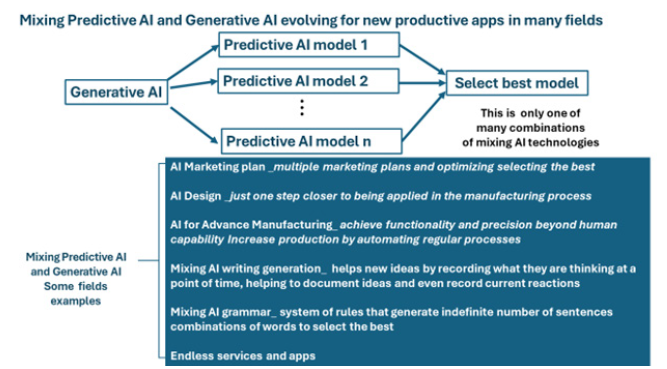
Figure 7: Mixing Predictive AI and Generative AI evolving from chatbot to new productive apps in many fields.
“Mixing AI on design” uses AI to some extent, but it is just one step closer to being applied in the manufacturing process.
3. “Mixing AI for Advance Manufacturing” is applying AI tools to achieve functionality and precision beyond human capability. Increase production by automating regular processes:
a. Robotics for prototyping and building optimize their utilization of sensory inputs like vision, touch, temperature, sound, and others.
b. Additive manufacturing optimizes designs,
c. CNC machining path optimization to improve time,
d. Automated welding optimization
e. and many others.
4. “Mixing AI for coding generation” software to accelerate programs from developers generating the code needed to design allows:
a. Minimizing the learning curve,
b. Reduce coding errors,
c. Increasing productivity with faster results,
d. In general, developers and IT operators can speed up application modernization efforts and generate automation to rapidly scale IT environments
5. “Mixing AI writing generation” helps people to generate new ideas by recording what they are thinking at a point of time, helping to document ideas and even record current reactions to the idea’s documented.
6. “Mixing AI Grammar” used grammar as a system of rules that generated an indefinite number of combinations of words to select the best form of grammatical sentences in a specified language.
7. “Mixing AI for images” generates a combination of images using words describing the image required to help visualize the concept of a mental image.
8. Generative AI can be used in thousands of areas and is growing in the number of different apps for optimization and productivity.
New predictive AI, generative AI, and mixing AI technologies have the potential to revolutionize the way companies design, develop, manufacture, and operate. i.e., Microsoft launched partnership companies as Siemens Industrial Copilot, an AI-powered assistant to supercharge collaboration between humans and machines. Across industries, these will boost innovation, speed up code development, and tackle the shortage of skilled labor by using copilot innovation to write software for industrial automation systems like robots and others.
Understanding the AI advantages and avoiding the AI disadvantages is a must in the learning of the new AI technologies to develop amazing and productive services and applications.
Conclusions
Predictive AI, generative AI, mixing AI, and other new AI technologies have the potential to revolutionize everything companies do, workers do, executives do, hackers do, students do, etc. The main challenges for us are:
a) Open your mind to learning new AI technologies and be ready to change everything about how we are working with traditional but unproductive methods.
b) Detect the advantages and disadvantages of any AI technology.
c) Apply AI at work always automates with efficiency by applying optimization.
d) Think wisely about how to maintain a healthy balance between natural and artificial intelligence.
Remember: humans are the most important in the loop of AI technologies, not machines with AI.
Types of AI based on capabilities, which can be identified on three different levels as “weak or narrow AI,” “general AI,” and “strong AI,” [1]
1. “Narrow AI (ANI), a type of AI that enables a system to perform a dedicated task with intelligence, is now the most common available “AI system.”
2. “General AI (AGI),” a type of intelligence that performs any intellectual task with human-like efficiency, is the idea of having smarter systems that think like humans on their own.
3. “Strong AI (ASI)” is applied to a level of intelligence of systems or machines that could surpass human intelligence, and they could perform any task better than a human with cognitive properties.
In my experience, AI is still at an "ANI." New AI technologies at this time only appear to be at a general level identified as "AGI." But some scientists believe that AI could advance, reaching the AGI” someday very soon. The reality is that in a technological world evolving each day faster and faster, we must be prepared to learn and apply new AI technologies, recognizing their advantages and disadvantages. Apply them wisely, considering that humans are still at the center of making our world more prosperous, productive, innovative, and secure. If not, humanity's sense of technology could lose direction because in life technology helps, but there are more important basic elements that are necessary for human survival, such as water, land, nature, energia, and other human contact, and the human sense of sentiments, happiness, and self-realization that can only be reached with the development of their natural intelligence potential, serving others to have a better world.
Acknowledgement
None.
Conflict of Interest
None.
References
- Garza Ulloa Jorge (2022) Chapter 1-Biomedical engineering and the evolution of artificial intelligence, Applied Biomedical Engineering Using Artificial Intelligence and Cognitive Models, Academic Press pp. 1-37.
- Garza Ulloa Jorge (2022) The Healthy Balance Between Natural and Artificial Intelligence. Nov Res Sci 12(4).
- https://openlearning.mit.edu/news/what-will-future-education-look-world-generative-ai, May 4, 2024
- https://www.whitehouse.gov/briefing-room/statements-releases/2024/01/29/fact-sheet-biden-harris-administration-announces-key-ai-actions-following-president-bidens-landmark-executive-order/, May 4, 2024
- Garza Ulloa Jorge (2022) Chapter 3-Artificial Intelligence Models Applied to Biomedical Engineering, Applied Biomedical Engineering Using Artificial Intelligence and Cognitive Models, Academic Press pp. 113-173.
- Garza Ulloa Jorge (2022) Chapter 4-Machine Learning Models Applied to Biomedical Engineering, Applied Biomedical Engineering Using Artificial Intelligence and Cognitive Models, Academic Press pp. 175-334.
- Garza Ulloa Jorge (2022) Chapter 5-Deep Learning Models Principles Applied to Biomedical Engineering, Applied Biomedical Engineering Using Artificial Intelligence and Cognitive Models, Academic Press pp. 335-508.
- Garza Ulloa Jorge (2022) Chapter 6-Deep Learning Models Evolution Applied to Biomedical Engineering, Applied Biomedical Engineering Using Artificial Intelligence and Cognitive Models, Academic Press pp. 509-607.
- Garza Ulloa Jorge (2022) Chapter 2-Introduction to Cognitive Science, Cognitive Computing, and Human Cognitive relation to help in the solution of Artificial Intelligence Biomedical Engineering problems, Applied Biomedical Engineering Using Artificial Intelligence and Cognitive Models, Academic Press pp. 39-111.
- Garza Ulloa Jorge (2022) Chapter 7-Cognitive learning and reasoning models applied to biomedical engineering, Applied Biomedical Engineering Using Artificial Intelligence and Cognitive Models, Academic Press pp. 609-676.
- (2024) What is HITL (Human-in-the-Loop) in Chatbots?. Ometrics.
- Avyay Casheekar, Archit Lahiri (2024) A contemporary review on chatbots, AI-powered virtual conversational agents, ChatGPT: Applications, open challenges and future research directions, Computer Science Review 52: 100632.

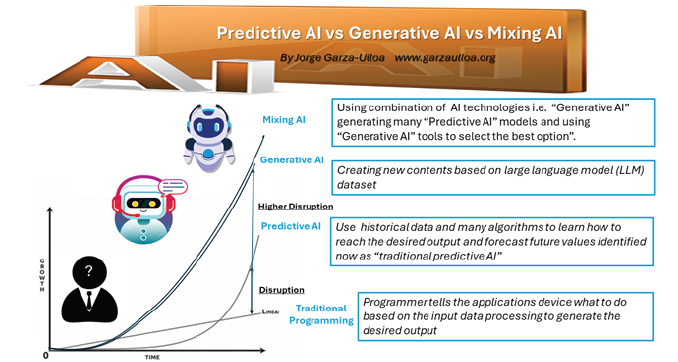
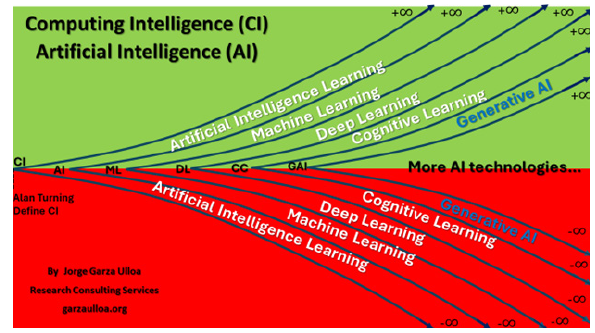
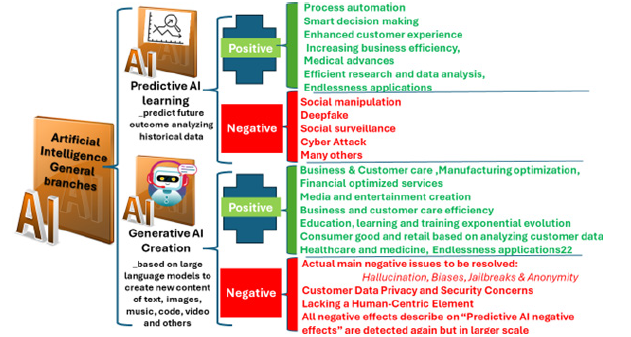


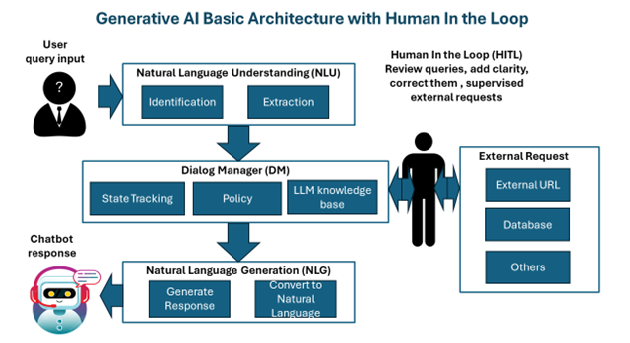

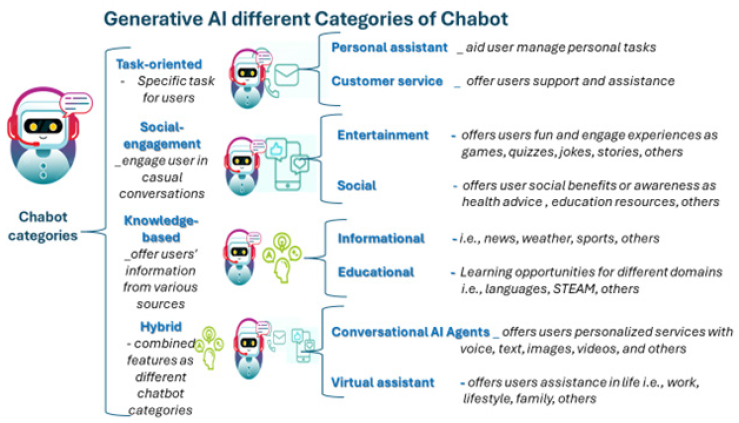


 We use cookies to ensure you get the best experience on our website.
We use cookies to ensure you get the best experience on our website.